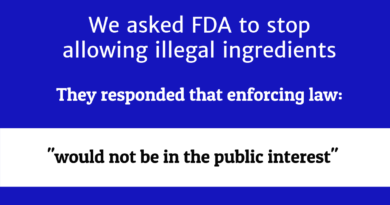What the FDA allows in pet food that the USDA doesn’t allow in ANY food – Truth about Pet Food
The FDA and USDA have very different perspectives on what can become pet food.
The Food and Drug Administration (FDA) and the United States Department of Agriculture (USDA) are two different federal agencies with very different perspectives of what is safe for pets to consume.
Both agencies regulate food, but each has its own jurisdiction. The FDA regulates products that contain 3% or less raw meat and the USDA regulates products that contain 3% or more raw meat. But, for some unknown reason, the FDA regulates pet food (even though most products contain more than 3% raw meat). It’s very unfortunate that the FDA has been given jurisdiction over pet food.
Below are just some examples of what the USDA considers to be inedible – not considered safe in human food or pet food:
- “Section 381.78(b) states that “when a lot of poultry suspected of containing biological residues is inspected in an official establishment, all carcasses and any parts of the carcasses in such lot which are condemned shall be kept separate from all other condemned carcasses or parts.”
- “carcasses of poultry affected with tuberculosis shall be condemned.”
- “carcasses of poultry affected with any one or more of the several forms of the avian leukosis complex shall be condemned.”
- “carcasses of poultry showing evidence of any septicemic or toxemic disease, or showing evidence of an abnormal physiologic state, shall be condemned.”
- “carcasses of poultry showing evidence of any disease which is characterized by the presence, in the meat or other edible parts of the carcass, or organisms or toxins dangerous to the consumer, shall be condemned.”
- “any organ or other part of a carcass which is affected by a tumor shall be condemned when there is evidence of metastasis or that the general condition of the bird is found to have been affected by the size, position, or nature of the tumor, the whole carcass shall be condemned.”
- “that carcasses of poultry contaminated by volatile oils, paints, poisons, gasses, scald vat water in the air sac system, or other substances which render the carcasses adulterated shall be condemned.”
- “Organs or parts of carcasses found to be infested with parasites shall be condemned.”
Unfortunately, the FDA considers all of the above to be suitable for animal food; “we do not believe that the use of diseased animals or animals that died otherwise than by slaughter to make animal food poses a safety concern and we intend to continue to exercise enforcement discretion.” Per this FDA belief, any of the above condemned meat material is allowed to be processed into pet food (with no warning or disclosure to pet owners).
The FDA’s perspective is if condemned material is cooked (heat treated) it miraculously becomes suitable for use in animal food; “Because the rendering and canning processes adequately dealt with any microbiological contamination, FDA concluded that applying enforcement discretion to the use of tissues, including from animals that were diseased or died otherwise than by slaughter, for rendering and canning would not present any food safety concerns.”
The USDA’s perspective on pet food is very different. USDA states all pet food meat/poultry ingredients should be inspected and passed (just like human food); “Meat means the U.S. inspected and passed and so identified clean, whole-some muscle tissue of cattle, sheep, swine, or goats.” The USDA’s perspective of inspected and passed material in pet food even includes by-products; “Animal food meat by-product means the part other than meat which has been derived from one or more cattle, sheep, swine or goats that have been U.S. Inspected and Passed and is fit for use as animal food.”
How can two U.S. federal agencies have such a different perspective of what pets can consume?
Perhaps the answer to that question can be found in their respective jurisdiction. The FDA’s jurisdiction – with the exception of pet foods – is only products that contain small amounts of meat (less than 3%). The FDA isn’t skilled or properly trained to understand the risks involved with condemned meat materials, meat isn’t FDA’s jurisdiction. But meat and the risks involved with condemned material is USDA’s jurisdiction. And the USDA makes it perfectly clear – pet food ingredients should only be sourced from inspected and passed meats.
Pet owners are encouraged to ask the FDA why they have such a dramatically different perspective of safe pet food ingredients than USDA; ask them to provide you the scientific evidence that condemned material is safe for pets to consume. Email FDA at: AskCVM@fda.hhs.gov
Wishing you and your pet(s) the best,
Susan Thixton
Pet Food Safety Advocate
TruthaboutPetFood.com
Association for Truth in Pet Food

Become a member of our pet food consumer Association. Association for Truth in Pet Food is a a stakeholder organization representing the voice of pet food consumers at AAFCO and with FDA. Your membership helps representatives attend meetings and voice consumer concerns with regulatory authorities. Click Here to learn more.
What’s in Your Pet’s Food?
Is your dog or cat eating risk ingredients? Chinese imports? Petsumer Report tells the ‘rest of the story’ on over 5,000 cat foods, dog foods, and pet treats. 30 Day Satisfaction Guarantee. www.PetsumerReport.com
Find Healthy Pet Foods in Your Area Click Here

The 2020 List
Susan’s List of trusted pet foods. Click Here to learn more.




